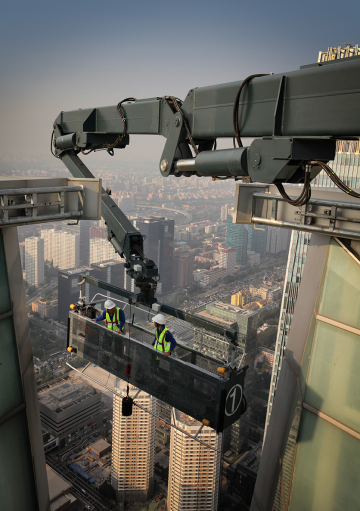While utilising anchorage points for a rope access building maintenance approach based on abseiling may seem to be an economical option, it is crucial to consider the functionality for thorough long-term building maintenance. The initial financial cost is one factor to consider when determining if a building maintenance approach is cost-effective. To ensure that your building’s façade is maintained in optimal condition for years to come, a building maintenance unit is a wise investment to protect the appearance and viability of your building. According to studies, the continuous expenditures for cleaning rope access abseiling systems can be much higher than those using a Building Maintenance Unit (BMU). It can cost up to two or three times as much to hire abseil operators as it does to hire BMU operators.
A straightforward rope access abseil system might be sufficient for routine window washing on structures with shorter heights and uniform shapes. However, a building maintenance unit can be easily deployed to handle a broader range of essential maintenance tasks conveniently. With the addition of material hoists, a BMU facilitates timely, cost-effective repairs and replacement of windows and facade panels. The BMU cradle provides a significantly greater capacity for transporting operators, tools, and materials. In contrast, abseiling requires additional “pod bags” to carry tools and equipment. Lighter individual tools are frequently connected to the operator or the pod bag. If their size or weight exceeds what this line-based system is capable of securely handling, any heavier tools will require an additional independent rigged line.
A Building Maintenance Unit will require a schedule of suitable maintenance and upkeep, like that required for any equipment to guarantee that it keeps operating at the highest levels of safety and efficiency throughout its lifetime. However, there are ongoing costs for rope access abseiling systems, and it’s also necessary to regularly examine and certify mooring sites.
Building owners and architects should pay close attention to safety as another essential concern when cleaning cycles need to be performed on a building; abseiling is a riskier option than employing a facade access system such as a building maintenance unit, especially when structurally complicated forms are involved. The usage of a BMU provides a reliable solution to minimising accidents and protecting operators, people within buildings, and the public walking underneath. To carry out all maintenance procedures safely and effectively, CoxGomyl’s building maintenance units depend on precise engineering, rigorously tested safety equipment, and qualified workers.
When it comes to cleaning cycles, a well-designed BMU system that has been carefully selected to match the unique requirements of a building, typically completes the cleaning of any given facade faster than abseiling operators. It has been claimed that a rope access system offers some flexibility because more abseil operators can be employed on an as-needed basis to handle specific short-term cleaning requirements. However, this flexibility is constrained by the availability of anchor points for many abseil operators to work at once. Engaging additional abseil operators incurs more expenditure.
A complete facade access solution which anticipates the various needs of each facade section and delivers appropriately tailored cleaning cycles with greater frequency of cleaning where necessary can be developed with help by a highly skilled, industry-leading provider of facade access solutions like CoxGomyl. This enables the facade to be maintained consistently, with predictable outcomes and improved budget management for facade maintenance.
Back to News